CCLHP: Procedures
(Note: These procedures reflect previous work on the legal database. These remain as part of the historic record for the creation of the Coles County Legal History Project, but do not reflect ongoing work.)
Since 1997, student researchers have read legal records, and have coded and entered the relevant information into a MS Access 97 database. (The current form used is pictured to the below.) The procedures for exporting this MS Access database into a postgreSQL database [Perl, Structured Query Language (SQL)] are given below. (Note: understanding the MS Access program is unnecessary to understand or use the online database.)
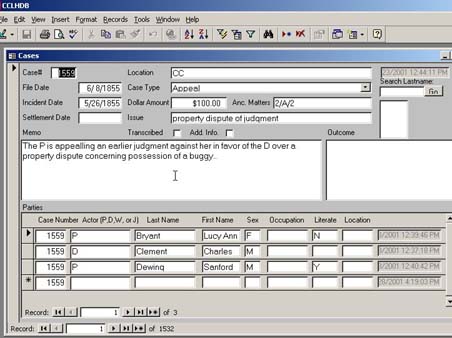
The procedures followed for inputting information include:
- Each case is assigned automatically a unique case number (the original cases were not numbered and were boxed with little regard to date). There are many documents in each case-summons, verdicts, etc.
- The document that best explains the nature of the case is the Declaration (often titled the appeal bond). This document usually has a file date, which is of high importance for the database.
- From the Declaration, we can find plaintiff(s) and defendant(s) and we have a separate but linked database for information on each plaintiff or defendant. (Gender is usually obvious from the party's name; literacy can be determined whether or not the party signs his or her name; sometimes occupation is given.)
- To be entered in court, each case must be of a certain legal type, which is different from the issue in laymen's terms. Thus, a case type might be the legal process of "Assumpsit," whereas the issue might be simply debt.
- Sometimes the location of the case stems from a change of venue or regards property outside Coles County. We pay particular attention to that.
- The dollar amount is often mentioned (most cases are for debt). An outcome is not determinable unless there is a specific jury verdict. So far, procedure suggests that many of these cases never came to trial.
- Finally, a large memo box in the database is used to record case information not in the other categories. For example, someone representing the estate of a deceased party is a common fact noted in the memo.
Naming conventions for database:
- CC, Charleston = Charleston, Coles County, Illinois
- CC, Township 11 R 34 E, etc. = the 11th Township in Coles County, Illinois
- CC = Coles County, Illinois
- Paris, IL = Paris, Illinois
- St. Louis, MO = etc.
- In Memo, P(s) = Plaintiff(s), D(s) = Defendant(s)
Conversion from MS Access to SQL Database (note: none of the following is necessary to understand or use the database and is included only for current researchers and those seeking to set up something similar)
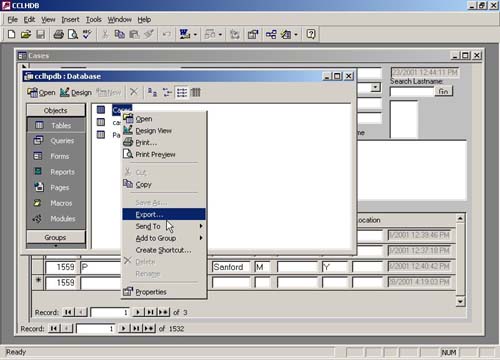
First step, in tables mode, right click on export (this is MS Access 2000, which is slightly different from currently used MS Access 97).
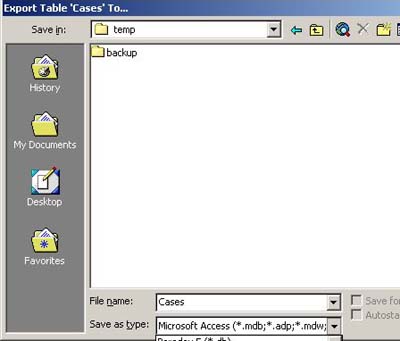
Second step, save a txt file type.
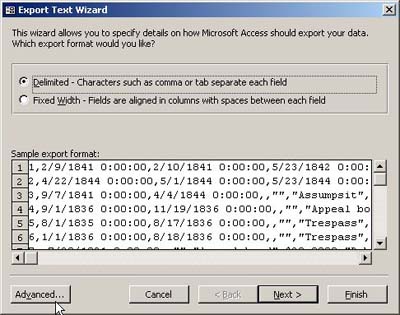
Third step, in export wizard is to go to "Advanced..." (keep delimited field type).
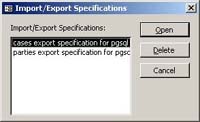
Fourth step, which I am not sure of, is to open import/export specifications from "Specs..." in "Advanced..."
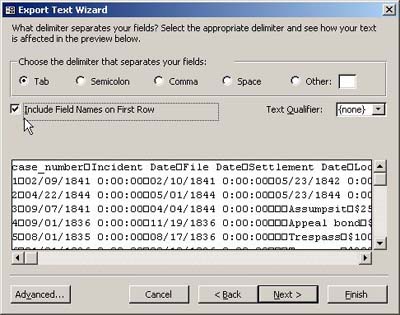
Fifth step, is to tick "Include Field Names on First Row." One can now go on to "Finish."
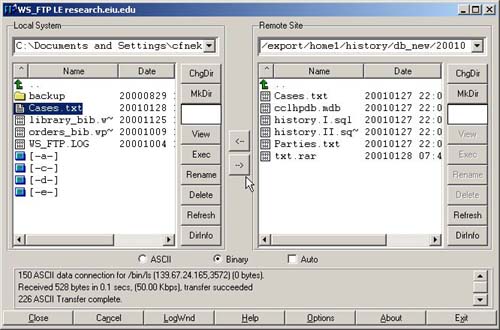
Finally, do the same for parties (creating Parties.txt), and send over both to location of database server using WS_FTP. Create new directory with current data under db_new and copy Cases.txt and Parties.txt and sql programs (history.I.sql and history.II.sql) over as well. It should be ready to run online at this point.








